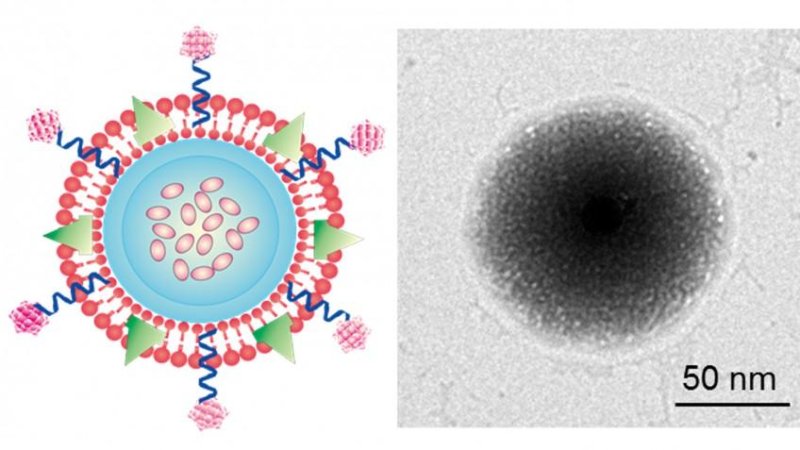On the left is the schematic design of the TRAIL/Dox loaded platelet membrane-coated nanogel delivery system. The TRAIL is attached on the surface of membrane and Dox is loaded in the core of nanogel. On the right is a transmission electron microscope image of the drug delivery system. Black is the synthetic core nanogel, the outside shell is the platelet membrane. Photo by QUANYIN HU/NC State and UNC Chapel Hill
RALEIGH, N.C., Sept. 29 (UPI) -- Researchers have developed a method to coat cancer drugs with membranes from a patient's own platelets, which helped the drugs stay in the body longer to attack primary tumors and circulating tumor cells that can cause cancer to spread.
In mice, the platelet membrane method allowed drugs to stay in the animal's bodies far longer and was more effective than delivering the drugs without a membrane.
"This combination of features means that the drugs can not only attack the main tumor site, but are more likely to find and attach themselves to tumor cells circulating in the bloodstream -- essentially attacking new tumors before they start," said Quanyin Hu, a doctoral student in the joint biomedical engineering program at North Carolina State University and the University of North Carolina Chapel Hill, in a press release.
Researchers started by taking blood from the mice and isolating platelets in order to separate their membranes. The membranes are then placed in a solution with nanoscale gel that includes the cancer drug doxorubicin. The solution is compressed, which forces the gel and drug through the membrane, creating nanospheres that are finally treated with another cancer drug, TRAIL.
The two drugs work in tandem, as TRAIL attacks the membranes of cancer cells and doxorubicin attacks the nucleus of cancer cells.
When the platelets come into contact with a tumor, the platelets bind to the surface of cancer cells. TRAIL on the outside of the platelets attacks the cancer cell's membrane, causing the nanosphere pseudo-platelet to be swallowed by the cancer cell. Once inside, the nanosphere is broken apart and the hidden doxorubicin attacks the cancer cell's nucleus, killing it.
In the research in mice, not only did the platelet-containing nanospheres remain in their bodies for 30 hours, as compared to 6 for the gel alone, but were far more effective against large tumors, the researchers reported.
"We'd like to do additional pre-clinical testing on this technique," said Zhen Gu, also an assistant professor. "And we think it could be used to deliver other drugs, such as those targeting cardiovascular disease, in which the platelet membrane could help us target relevant sites in the body."
The study is published in Advanced Materials.















